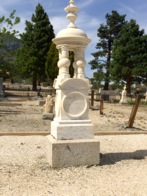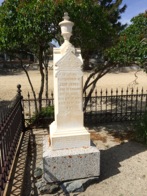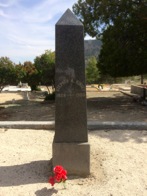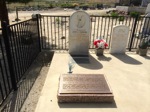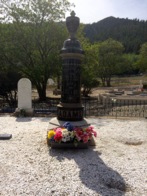A History of the Genoa Cemetery
by
Billie J. Rightmire
September 9th, 1897, J.W. Haines and wife Rosa, deeded seven (7) acres to the Douglas Lodge No. 12, F & A.M., and Genoa Lodge No. 15 - I.O.O.F., and Douglas County for the sum of $1.00 gold coon, a certain parcel of land north of the Haines home to be used as the Genoa Grave Yard. At the time, 1897, and through a chain of property ownerships. this land was already being used as a place for burial. Senator Haines and his wife purchased their 320 acres of Genoa property in 1877.
Cemeteries are often sectioned into several areas. The Genoa Cemetery, as per the deed, had a Genoa Section, an Odd Fellows Lodge Section (I.O.O.F.) and a Masonic Lodge Section F & A.M.) A small Indian Section is located at the Northeast corner of the Cemetery. The Genoa Cemetery Association was formed in the early 1950’s.
Some cemeteries are often referred to as “Boot Hill”. This is a term for cemeteries where gamblers, murders, rustlers, etc., are buried but not the usual cemetery where men of wealth, the mainstay of the community, the shopkeepers, the business people and their families are burred.
NOTE: It is tradition to bury the dead with the feet toward the East so on Resurrection Morning the immortal rises facing the sun.
Our ancestors used many means to mark the graves of their loved ones: a board; a heap of stones, or a single boulder; a slab of slate, marble, limestone, granite, or sandstone. Pioneers to the West fashioned markers form whatever lumber was available. Sometimes a spring wagon was broken up and the wood used for a coffin as well as the grave marker. In this area of Nevada, stone cutters set up shop in about the 1870’s.
Stone grave markers are an art form defending from ancient Greece where headstones were carved with the same technique as the statues were carved. Down through history, stone cutters plied their trade using the same techniques and the same type of tools. A chisel and a round headed hammer. The stone carver took great pride in his work and often signed his signature at the bottom of the grave marker.
In America, gravestones were meant chiefly to identify grave sites although markers have served many purposes. They usually give the birth and death dates and occasionally the place of birth. In some European countries, a single tall stone, usually four sided, was placed in the center of a family plot and as a family member died, their name, dates, and sometimes other facts were carved in the huge stone so that by the time the grandparents, parents, children and possibly other family members such as aunts, uncles, or cousins died, the stone would be totally covered on all sides with a family history.
During the WPA (Works Projects Administration) period, (1930’s) workers were cleaning the Genoa Cemetery of sage brush, etc., and stacked all of the thud wooden grave markers and wooden picket fences with the piles of brush and burned them before anyone in Genoa realized this was happening. We now have only a very few wooden markers.
